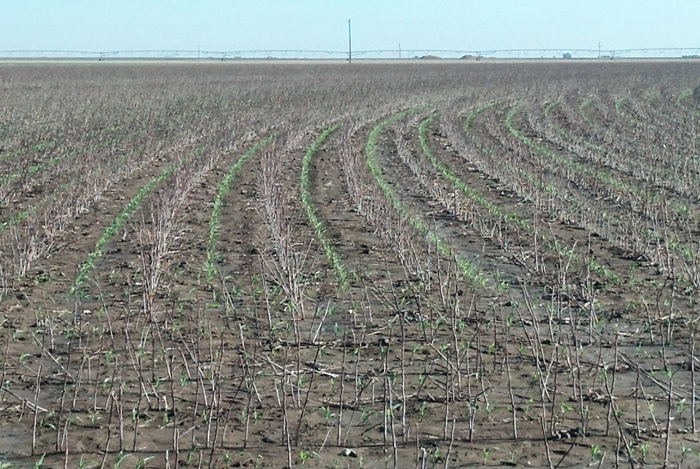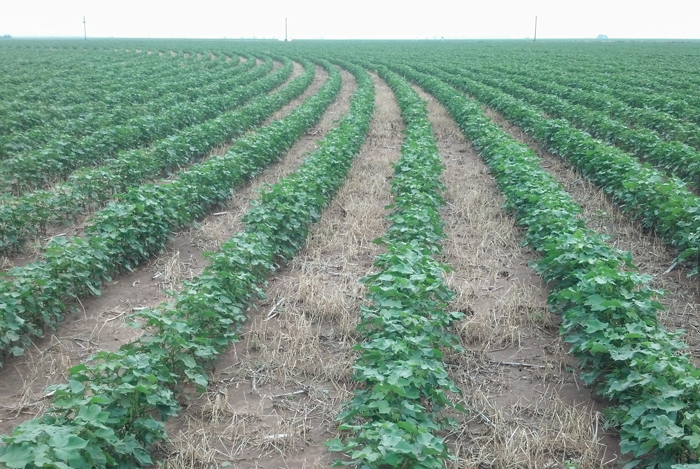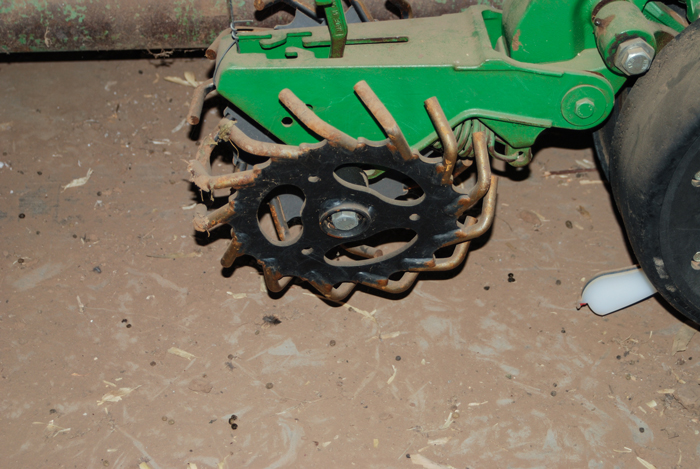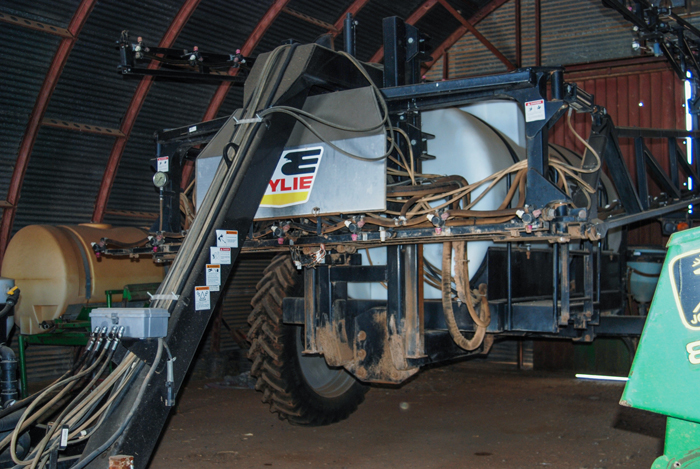Given short groundwater conditions, Davy Carthel and his son, Andy, are incorporating more dryland no-tilling practices on 4,000 acres they farm individually, and as partners, near Friona in the western Texas Panhandle.
They grow wheat, cotton, grain sorghum and corn on a variety of soil types using sprinkler pivots and drip irrigation on irrigated land, and an array of practices on dryland acres that include numerous pivot-circle corners.
On some land they can only irrigate half the section due to limited irrigation-well capacity, and must dryland farm the other half. Recent years have seen the Carthels using a combination of conventional and strip-till, but now they’re beginning to use no-till.
The continuing rapid decline of the Ogallala aquifer in their area means that more dryland production will be the trend of the future, with more no-till to save moisture. The Carthels are edging more and more into no-till on their dryland acres that make up just over a third of their overall farm. Irrigated acres currently make up roughly two thirds of their farm.
“Depending on the soil of different farms, we’ve been trying some no-till cotton planted into the stubble from a preceding harvested or failed sorghum crop, on 38-inch rows,” Andy says.
In the early stages, they’ve been moving over 19 inches and planting between the old rows with a John Deere 1720 12-row planter rigged with row cleaners to move residue and get down to moisture if the topsoil is dry. They’ve added Keeton seed firmers behind each seed tube and Schlagel closing wheels.

Andy Carthel and his father, Davy, are no-tilling cotton and corn in terminated wheat residue, as well as stalks from the preceding cotton crops.

They’ve found that even cotton stalks provide a surprising amount of wind protection when left in place. The Carthels plant 38-inch rows and move over 19 inches to plant the succeeding crop in their no-till effort.
“They give good seed-to-soil contact,” Andy explains.
Managing No-Till Stubble
The Carthels have also no-tilled cotton into wheat stubble from the previous harvest, or into wheat planted as a cover crop and terminated with glyphosate at boot-top height.
They’ve found when planting cotton into wheat stubble, the spring after wheat harvest, that the stubble has decomposed by cotton-harvest time and hasn’t impacted harvester operation or lint quality — so long as the stubble isn’t too tall.
“This works well behind combine harvested 40 bushel-per-acre wheat stubble that’s 8 to 10 inches tall,” Davy observes. “In stubble left from 80-100 bushel per acre wheat that was over 10 inches tall we didn’t get the cotton up to a good stand — possibly because the soil was cooler. It does make a difference planting in cover, though.”
Davy says they have a 30-foot Great Plains drill with opening discs on 7½-inch spacings and hydraulic down pressure. They’ve added a second 15-foot Great Plains no-till drill paired with a coulter-caddy cart running coulters in front of the drill’s 7½-inch disc openers, which is used for planting small grains into cotton stalks or sorghum residue.

Andy and Davy Carthel are making good use of Keeton seed firmers (lower left) behind each seed tube — to improve seed-to-soil contact — and Schlagel closing wheels on their John Deere 1720 12-row planter, as they plant cotton into residue from harvested or terminated wheat.
“Even cotton stalks left standing will give you some wind protection,” Davy says. “This Great Plains no-till drill will cut right through cotton stalks or sorghum residue when we’re sowing rye or wheat into standing cotton stalks or crop residue.
“We were going to sow wheat into cotton stalks this past fall but weather conditions caused cotton harvest to run late and we didn’t finish cotton harvest until December and missed our planting window for the wheat cover.”
Saving $11 an Acre
Davy and Andy initially delved into no-tilling into standing residue in order to prevent fields from blowing and eroding. They’ve discovered that soil moisture-holding capacity is enhanced with the presence of residue and it’s making a big difference.
"Obviously, one of the big factors in no-tilling on dryland acres is saving the moisture that’s in the subsoil and not turning the soil over and drying the ground out,” Andy says. “There may not be a precise way to measure the value of conserving that moisture, but it costs at least $11 an acre-inch in pumping costs to put moisture in the ground through irrigation. So I feel like we’re saving at least $11 an acre if we can save an inch of moisture — and probably more if you preserve more moisture through no-tilling.

A pull-type Wylie sprayer equipped with a 1,250-gallon tank and Swath Control Pro and GPS guidance as an integral part of their weed control and cover-crop termination efforts. The Carthels like the pull-type sprayer because it’s more affordable and allows them use of a tractor when the sprayer isn’t being used.
"You can also figure that you will trade tillage passes with a higher-horsepower tractor for a lighter work load with a planter and sprayer,” he adds. “You still have some costs associated with taking care of the weeds, but you have diesel fuel savings and spraying is a lot faster than plowing.”
Andy and Davy got into no-tilling mostly by making equipment they already had work.
"Our drills can work in either conventional or no-till farming, and we just added Schlagel closing wheels and Keeton seed firmers to the planter — and they also work in conventional or no-till farming,” Andy says. “If we go full-fledged into no-till on all of our acres we might change our equipment more, but we’re making what we have work. Any money or moisture that we can save by no-tilling is something we can use.”
Reality Check
Davy says they’ve adjusted their yield expectations in light of a declining aquifer and frequent drought conditions. This season he plans to plant dryland grain sorghum later — well into June — so the plants will be at their peak water-use stage when the driest and hottest part of the summer has already passed and there are chances for rainfall in August.
“We’re not going after yield home runs. We try for average yields to stretch the water over the acres we can still irrigate, and to best utilize moisture on dryland acres,” Davy says. “We can dial down the vacuum planter to 1 or 1½ pounds of seed per acre. We think in terms of seeds per acre. We use 32,000 to 35,000 seeds an acre for irrigated sorghum, and 28,000 to 30,000 plants per acre in cotton. In dryland sorghum we plant 25,000 plants per acre.”
They use a GPS-guided, pull-type Wylie sprayer, equipped with John Deere Swath Control Pro guidance system, a 100-foot boom and a 1,250-gallon tank to handle weed-control duties across the farm.
“The Swath Control Pro shuts off the boom very precisely on angled rows when we turn, and we avoid overlaps and double spraying,” Davy says. “We prefer the pull-type sprayer because it’s cheaper than a self-propelled, and when we’re through spraying we still have a tractor to use for other work while the sprayer goes back in the barn when it’s not in use.”
Making Another Run
Davy says they’ll test no-till waters more at planting this spring. They’ll use the Deere 1720 equipped with Yetter trash whippers to plant silage sorghum into undisturbed residue from white corn harvested last fall.
As with cotton, they’ll be moving over 19 inches to place seed between the old 38-inch corn rows. They’ll pay special attention to getting sufficient down pressure from tension springs to make sure the planter units make good seed-to-soil contact.
“This will be our second try this spring at planting cotton into residue of a dryland grain-sorghum crop that didn’t quite make grain,” Davy says. “We’ve had some moisture this winter and the standing sorghum residue has helped us save moisture we received, so we want to take advantage of that.
“Growing cotton limits us somewhat in our rotation. On dryland acres where we can’t change much, we will continue to grow wheat, sorghum and cotton. We like to work our rotation so that we can plant cotton into standing sorghum stubble.”
Andy represents the 5th generation of his family to farm. His interest in no-tilling with cover crops was piqued at the Southern Soil Health Conference in Fort Worth, Texas, earlier this year. “I’m trying to come to the way of using covers — in fact, I was looking at cutting some oat hay and coming right in with covers this spring, but I haven’t found a way that oat hay will work,” Andy says.
He admits being a bit torn about his no-till journey, acknowledging it has benefits but he’s concerned about how he will keep weeds at bay — especially herbicide-resistant Palmer amaranth (pigweed) that has been spreading across his region.
“If we can get going with no till and use terminated or live covers, and let the cover crops and residue choke out the weeds, that would be a big help, but it takes time,” Andy says. “I know that more dryland farming with no till is the trend of the future for us.”






